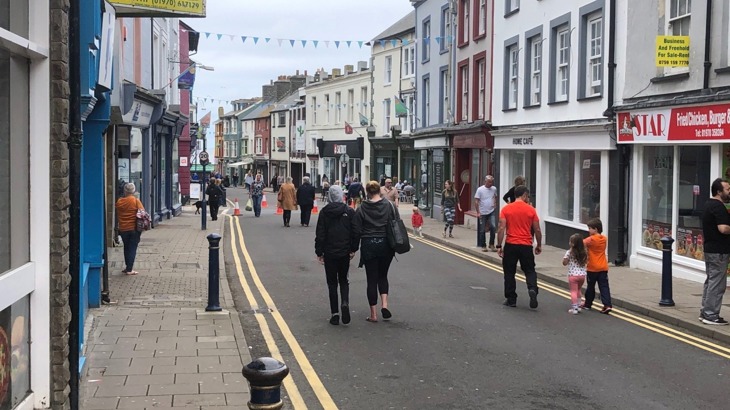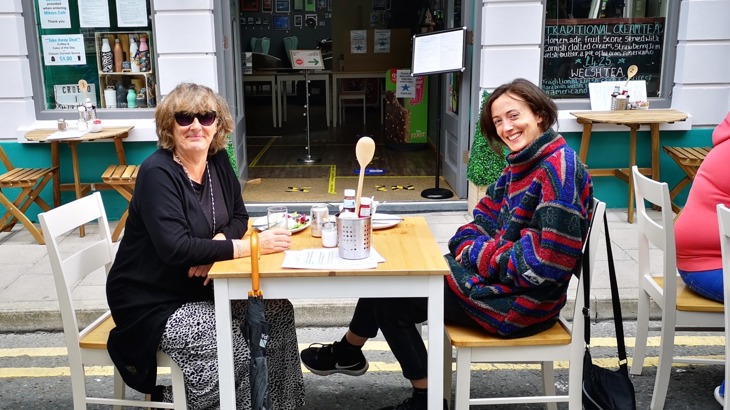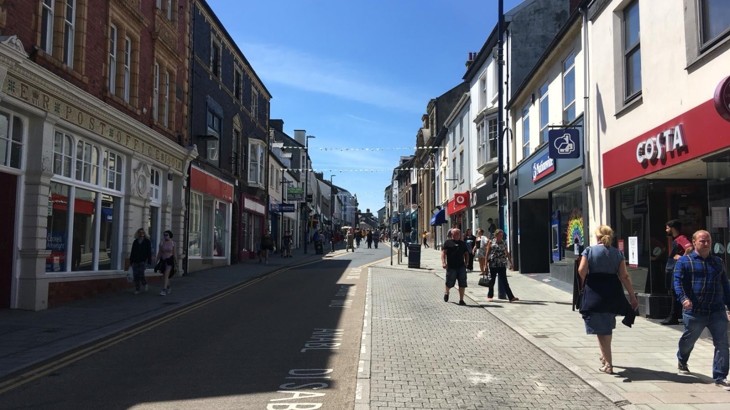In order to create safe and inviting towns for people to visit, shop and enjoy during the Covid pandemic, Ceredigion County Council created Safe Zones in 4 towns across the county. Roads have been closed to traffic, pavements de-cluttered, and visitors asked to park away from the town centres. Here, Ceredigion County Councillor and the Council’s Sustainability Champion, Alun Williams, talks about Safe Zone planning, delivery and the next steps.

To begin with, Ceredigion has had a good Covid lockdown.
Closing down care homes and tourist accommodation early, the setting up of a local contact tracing system and a co-operative population who have taken the threat seriously have all helped the county to the lowest rate of Covid per head in the whole of mainland UK.
But the easing of the lockdown and the delayed start to the tourist season brought a new challenge.
Tourism in Ceredigion
Always a busy time for beautiful coastal Ceredigion, the likelihood of thousands of additional tourists, deprived of holidays abroad, arriving from more Covid-prevalent areas was a serious concern.
With small shops unable to allow more than two customers in at a time, people began queuing outside, squeezing the already narrow pavement space and raising obvious concerns about social distancing.
There was a clear potential for Ceredigion to switch almost overnight from a low Covid area into seeing a major spike.
Balancing business with health
At the same time, local businesses were in a parlous state. Desperate to re-open to start recouping lost profits but severely restricted in how they could do this, the question each business was asking was whether they could afford to re-open at all.
The County Council’s highways officers were therefore asked to come up with a scheme that would quickly address these twin worries of health and the local economy in the county’s main coastal towns of Aberystwyth, Aberaeron, New Quay and Cardigan.
It was clear that closing the streets to traffic could tackle both issues at once.
Without traffic, pedestrians could maintain social distancing by spreading out across the whole carriageway whilst the extra space would allow businesses to expand out onto the pavements - the only way many could be viable under lockdown restrictions.
In normal times such a bold idea would require many months of public consultation.
But there was minimal time for that.
Governments were changing the rules around Covid every few days.
Normal ways of operating were entirely suspended by Covid legislation and the threat to health and economy remained pressing.
If county councils were to keep up with the fast-changing situation, they had to act just as fast.
Adjusting for reasonable concerns
To allow time for deliveries, street closures were set to 11 am-6 pm.
Businesses who felt their trade depended on cars being able to pull up outside all day still reacted furiously, so wherever possible the Council made adjustments and allowances to take account of reasonable concerns.
Food outlets reacted tentatively at first, gradually advancing tables and chairs onto the streets.
In Aberystwyth, as the first customers tried the new experience of eating lunch on the side of the town’s main trunk road, more tables were put out to cater for the demand… and then more.

European-style street atmosphere began to pour in from both locals and visitors
The Town Council - who had backed the county’s plans from the start - hired buskers to improve the street ambience further.
Slowly the mood changed, even amongst initially sceptical businesses, and the positive comments about the relaxed, European-style street atmosphere began to pour in from both locals and visitors.
A wider agenda
Of course, as well as the Covid health and business imperatives that drove it, the scheme has jumped the county into another agenda.
For years there have been calls from transport, climate and health campaigners to restrict car use in our towns in line with the spirit of the Welsh Government’s Well-Being of Future Generations Act.
This naturally creates healthier, more people-friendly streets that people want to spend time in and therefore helps local economies to thrive whilst reducing pollution and carbon emissions.
But local debates about pedestrianisation tend to become quickly polarised, with environmentalists and the cautious but powerful business community cancelling each other out.
It may not have felt very democratic, but the emergency legislation necessitated by Covid has allowed this perennial argument to be bypassed.
People have been able to see, feel and quantify for themselves the real life practicalities of traffic-free town centres without a lengthy ‘what if’ debate first.
Positive feedback
After three weeks of the scheme, the Council ran an online survey. 2,065 people responded with a total of 17,100 separate comments.
A clear 64% supported the measures either broadly or strongly with only 27% disagreeing.
A majority also said the impact on businesses was good.
The only failure - an important one - was that a majority felt the changes had been detrimental to the disabled and elderly.

If the current arrangements are judged enough of a success, it would be hard for the council to ignore calls for something longer lasting.
Moving forward
So what next?
The Council is in regular touch with the local Disability Forum and the scheme in all four coastal towns is set to continue until at least the end of September, with legislation in place that could potentially allow a further 18 months.
Where we’ll end up is a genuine unknown.
The scheme was sparked by the immediate emergency circumstances without thought of a longer-term plan.
But if the current arrangements are judged enough of a success, it would be hard for the council to ignore calls for something longer lasting.
This could range from making the whole thing permanent (unlikely where trunk roads are involved) to keeping selected streets traffic-free or re-visiting the scheme as a regular seasonal event.
Whatever is decided, the Covid crisis has allowed Ceredigion to shortcut the usual processes into a traffic-free pilot that could become a model for more enlightened use of space in our towns.
Share your thoughts on these changes with our Space to Move map.





